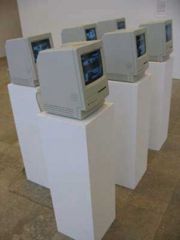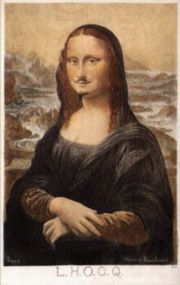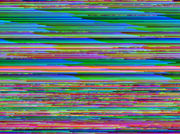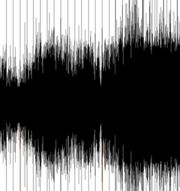Internet Art
From digitalhumanities
[edit] Art is either plagiarism or revolution. Paul Gauguin (1848 - 1903)
[edit] Introduction
Think of five major works of art. Now, think, out of those five works, how many you have seen in their original form? Unless you have been fortunate enough to have had the means to travel to the world's major museums, you, like the majority of people familiar with these works, have been viewing only representations of some far away original piece of art. Even most art students' relationships with masterworks have become mediated ones; we view slides, we look at books, and watch documentary films. Internet art is different. When you view artworks created online you are viewing them in the medium in which they were created and in which they were intended to be viewed, regardless of your particular browser. This fact could be what sets internet art apart as a truly revolutionary art movement.
Internet art can take on different forms, but it is generally thought of as only those works which are "born digital". It is not a photograph of a painting posted to a website. Many internet artworks lead the viewer through a number of links rewarding them with graphics, text, animation, or even an invitation to alter the artwork themselves. Many proponents believe that the participatory nature of internet art is one of its most important and defining factors. This is exemplified in works like Mark Napier's net.flag, where Napier allows site visitors to manipulate a large image of a flag, "whose design changes constantly." The flag is meant to reflect the internets many and varied users and is used as an "emblem for the internet as a new territory." Jon Leonardo Ippolito, Curator of new media at the Guggenheim Museum, states in his article Ten Myths of Internet Art that: "What sets [internet] art apart from other technological endeavors is not the innovative use of technology, but a creative misuse of it. To use a tool as it was intended ...is simply to fulfill its potential. By misusing that tool-that is, by peeling back its ideological wrapper and applying it to a new purpose or effect that was not its maker's intention-artists can exploit a technology's hidden potential in an intelligent and revelatory way."
The aim of this web page is to give a basic overview of this movement and to look at how it fits into the larger theme of digital humanities and the traditional art world.
[edit] Guiding questions:
- Is any art on the web internet art?
- Can "Net.Art" be taught?/should it be?
- Is internet art dead?
[edit] History
It is not surprising to find that the word technology has its roots in the Greek word techne which has to do with skill in the arts. When one considers how technological advancements such as, print, photography, radio and film have been turned into a medium for artistic expression, it is, similarly, not surprising to acknowledge the rise of internet art and its modern take on our current mediated and digitized culture. Cyril Stanley Smith, a metallurgist at MIT, states that: "Technology is more closely related to art than to science-not only materially, because art must somehow involve the selection and manipulation of matter, but conceptually as well, because the technologist, like the artist, must work with unanalyzable complexities." (Nye, 2006)
To understand the history of internet art one must begin to understand, among other things, the history of the internet. Ricardo Miranda Zuniga (2002) observes:
"The internet began its commercial transformation in 1979, the year the National Science Foundation (NSF), once proprietors of the internet, agreed to sell part of its virtual frontier to Compu Serve. "Fifteen years later [Compu Serve] claimed 3.2 million users in 120 countries and was part owned by Time Warner. The NSF, finally, in 1995 handed the backbone and its management over to the private telecommunication giants Sprint, Ameritech, and Pacific Bell which became the gatekeepers of the principal access points." This is an all too familiar pattern of mass media, a pattern that has resulted in a highly limited production of independent radio and television programs. In the case of both telecommunications technologies, the dialogue potential was consumed by corporate enterprise."
During this time online art circles began to emerge, not only in celebration of a new medium but, also, in protest of the corporatization of the internet environment. "By 1995, eight percent of all websites were produced by artists, giving them an unprecedented opportunity to shape a new medium at its very inception."(Ippolito, 2002) Internet artists of the time sought to democratize and reclaim cyberspace through "building an equitable community in which art was conspicuously present in ones everyday activities". From its beginning internet art has relied little on its predecessors in the traditional, commercial art world, though one can see resemblances to previous artistic movements such as dada, performance and conceptual art. Rachel Greene (2004) describes internet art as having "...less to do with objects of social or financial prestige, and little, at least currently, to do with the cosmopolitan art business." She views net.art as: "a more marginal and oppositional form, often uniting parody, functionality and activism under a single umbrella, actively reclaiming public space and circumventing boundaries that seem entrenched in the world of galleries and museums."
Another contributor to the networked art scene of the mid to late nineties is the political climate of Eastern Europe at that time. Post-communist Europe embraced the online art world, and their access to it, with great enthusiasm. Many Eastern Europeans, such as Vuk Cosic, who coined the term net.art in 1995, helped shape this early history of internet art.
Some say that internet art had its hey day in 1998 and 1999. This could account for much of the literature on the subject pre-dating 2003, but is it the case? It is easy to be deceived by the abundance of what is labeled as "internet art" out there as it is difficult to tell if the work is current or if it is an artifact from the past. One currently active and well organized internet art presence is rhizome.org. They have been around since the early days and remain a good place to start an investigation and analysis of the current web presence of internet art.
[edit] Current Web Presence
[edit] "I am interested in the notion of art as culture hacking, art with a critical agenda that seeps outside the boundaries of prescribed art audiences and engages itself with a broader public."-Anne-Marie Schleiner
It is difficult to quantify the current presence of internet art as it is constantly shifting. One could almost call it a movement rather than a discipline as the majority of work done is explicitly political and the medium is inherently subversive. Net.art is just beginning to be recognized by more progressive members of the fine art community. Although many within the net art community would not necessarily consider that a success, the status and recognition of institutions played a big part in the shift from movement to discipline. There are quite a few online groups and websites that serve as community space for discussing, displaying and viewing net art and still countless other individuals who maintain their websites, often requesting participation from browsers.
Among the institutions beginning to recognize internet art are Guggenheim Networked Art Collection, the San Francisco Museum of Modern Art, the Tate and the Whitney. They offer web space accessible through their main website showcasing internet artists. The SF Moma page displays both a project overview and launch option for the handful of works on display online. The Tate offers more information on each piece, such as critical essays and biographies of the artist. An interesting piece featured on both the Tate and the Whitney is The Dumpster, a collection of web log break ups by Golan Levin with Kamal Nigam and Jonathan Feinberg. The artists extracted entries from millions of blogs that the viewers can browse. The Whitney offers, by far, the largest collection of the four museums. The net.art there can be browsed by ‘gate pages’ which connect the viewer directly with the internet artists, by works commissioned by the museum or by exhibitions of internet art and even features a resources page. This begs the question; does institutional recognition represent the long overdue reward for internet artists or the demise of the movement? In their cheeky Introduction to Internet Art writers Natalie Bookchin, Alexei Shulgin predicts net. art’s “Movement from impermanence, immateriality and immediacy to materialization.”
Outside of these major art institutions many websites exist as communities for internet artists and viewers online. The most popular of which is probably Rhizome. Rhizome is free to all users for a year or one can become a member for a low fee and view all achieves. The less flashy, content heavy netzwissenschaft has seemingly infinite links divided into categories often unrepresented in net art communities such as “publicists” and “writings” in addition to the “publication” and “website” sections.Intelligent Agent is both a print and digital magazine dedicated to new media. A slightly broader reach than Rhizome or netzwissenschaft, Intelligent Agent offers articles, an events calendar and a links directory all displayed very fashionably. All three offer incredible jumping off points in the search for internet art.
The internet is rich with independent artists some of whom may not even consider themselves part of the net.art movement. With a little browsing it is not difficult to uncover some incredible talents. Learning to Love you More is an interactive project of assignments created by Miranda July and executed by artists, students and other internet users. My boyfriend Came Back from the war initially created by Olia Lialina has since been reimagined many times by various web artists. The internet is inherently interactive and even the most passive users are invited to engage with the works of net.artists.
[edit] Research Guide
- wikipedia
- an outline
- Netzwissenchaft Links Guide
- Histories of Internet Art
- An Article by Rachel Greene
- Rhizome
- HEAVY INDUSTRIES
- Mark Amerika
- My Boyfriend Came Back from the War
- the Dumpster
[edit] References
- Goodman, Calvin J.(2002)The 'Net Value of the Art Market. Retrieved on 2.08.07 from
- Greene, Rachel.(2000)Web Work: A History of Internet Art. Retrieved on 2.06.07 from here
- Greene, Rachel.(2004)Internet Art. New York: Thames and Hudson
- Ippolito, Jon Leonardo.(2002)Ten Myths of Internet Art. Retrieved on 2.08.07 from here
- Nye, David.(2006)Technology Matters. Cambridge, Mass.: MIT Press
- Zuniga, Ricardo Miranda.(2002)The work of Artists in a Databased Society: Net Art as Online Activism. London; New York: Routledge
[edit] Gallery
"The bar graph maps the number of images resulting from Google image searches of every day from “January 1, 1907” to “January 1, 2007.” One pixel represents a day on the horizontal axis; one pixel represents an image on the vertical axis." 2007 archival inkjet print mounted on aluminum, Ed. of 7 with 2 APs 22 5/8 x 51 1/8 inches 57.5 x 129.9 cm
by: Max Protetch
[try it!]





